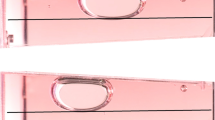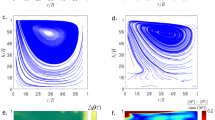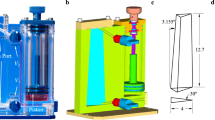Abstract
The multi-phase solver interFoam within the open-source CFD software OpenFOAM is newly applied to rare experiments conducted beginning over 10 years ago aboard the International Space Station (ISS). The fluid physics of interest concern large length scale passive capillary flows in a microgravity environment driven largely by surface tension, wetting conditions, and container or conduit geometry. Such flows are critical to orbiting and coast spacecraft liquid fuels, propellants, cryogens, thermal fluids, and aqueous streams for water management, recycling, and life support. The value of the simulations is assessed via quantitative comparisons to the ISS Capillary Flow Experiments (CFE) for a series of centimetric handheld test cells. Three representative flows are simulated as functions of geometric complexity: 1) bubble coalescence, 2) ullage migration, and 3) draining flow. The experimental data is newly digitized for the bench-marking effort. The favorable agreement between the simulations and experiments adds confidence for advanced applications of the native interFoam multi-phase solver of the OpenFOAM suite, where experimental data is scarce.








Similar content being viewed by others
Data Availability
The datasets generated during and/or analyzed during the current study are available from the corresponding author on reasonable request.
References
Alhendal, Y., Turan, A., Kalendar, A.: Thermocapillary migration of an isolated droplet and interaction of two droplets in zero gravity. Acta Astronaut. 126, 265–274 (2016). https://doi.org/10.1016/j.actaastro.2016.05.001. Space Flight Safety
Antritter, T., Mayer, M., Hachmann, P., Ag, H.D., Martin, W.: Suppressing artificial equilibrium states caused by spurious currents in droplet spreading simulations with dynamic contact angle model. Progress in Computational Fluid Dynamics, An International Journalpr 20(2), 59–70 (2020)
Berberovic, E.: Investigation of free-surface flow associated with drop impact: numerical simulations and theoretical modeling. PhD thesis, Technische Universität (2010)
Brackbill, J.U., Kothe, D.B., Zemach, C.: A Continuum Method for Modeling Surface Tension. 100(2), 335–354 (1992). 10902716. https://doi.org/10.1016/0021-9991(92)90240-Y
Concus, P., Finn, R.: On the behavior of a capillary surface in a wedge. Proc. Natl. Acad. Sci. 63(2), 292–299 (1969). https://doi.org/10.1073/pnas.63.2.292
De Lazzer, A., Langbein, D.: Liquid surface in regular N-pods. J. Fluid Mech. 358, 203–221 (1998)
Fu, J., Sunden, B., Chen, X., Huang, Y.: Influence of phase change on self-pressurization in cryogenic tanks under microgravity. Appl. Therm. Eng. 87, 225–233 (2015). https://doi.org/10.1016/j.applthermaleng.2015.05.020
Gurumurthy, V.T., Roisman, I.V., Tropea, C., Garoff, S.: Spontaneous rise in open rectangular channels under gravity. J. Colloid Interface Sci. 527, 151–158 (2018). https://doi.org/10.1016/j.jcis.2018.05.042
Gründing, D., Smuda, M., Antritter, T., Fricke, M., Rettenmaier, D., Kummer, F., Stephan, P., Marschall, H., Bothe, D.: Capillary rise–a computational benchmark for wetting processes. arXiv preprint arXiv:1907.05054 (2019)
Hou, H., Yuan, Z., Hu, Z., Gao, S., Wu, X.: Effects of the surface tension gradient and viscosity on coalescence-induced droplet jumping on superamphiphobic surfaces. Phys. Fluids 33(11), 112101 (2021)
Ludwicki, J.M., Steen, P.H.: Sweeping by Sessile Drop Coalescence. Eur. Phys. J. Special Topics (2020)
Malekzadeh, S., Roohi, E.: Investigation of different droplet formation regimes in a T-junction microchannel using the VOF technique in OpenFOAM. Microgravity Sci. Technol. 27(3), 231–243 (2015). https://doi.org/10.1007/s12217-015-9440-2
Manning, R.E., Ballinger, I., Bhatia, M., Dowdy, M.: Design of the Europa clipper propellant management device. In: AIAA Propulsion and Energy 2019 Forum, p. 3858. (2019)
McCraney, J., Bostwick, J., Steen, P.: Resonant mode scanning to compute the spectrum of capillary surfaces with dynamic wetting effects. J. Eng. Math. 129(1), 10 (2021). https://doi.org/10.1007/s10665-021-10150-2
McCraney, J., Weislogel, M., Steen, P.: OpenFOAM simulations of late stage container draining in microgravity. Fluids 5(4), 207 (2020). https://doi.org/10.3390/fluids5040207
McCraney, J., Weislogel, M., Steen, P.: The draining of capillary liquids from containers with interior corners aboard the ISS. npj Microgravity 7(1), 1–11 (2021). https://doi.org/10.1038/s41526-021-00173-5
Pingel, A., Dreyer, M.E.: Phase separation of liquid from gaseous hydrogen in microgravity experimental results. Microgravity Sci. Technol. 31(5), 649–671 (2019)
Ramé, E., Weislogel, M.M.: Gravity effects on capillary flows in sharp corners. Phys. Fluids 21(4), 1–12 (2009). https://doi.org/10.1063/1.3109685
Rusche, H.: Computational fluid dynamics of dispersed two-phase flows at high phase fractions. PhD thesis, Imperial College London (University of London) (2003)
Thomas, E., Graf, J., Sweterlitsch, J., Weislogel, M.: Development of the static phase separator. Development 1, 2041 (2008)
Torres, L.J., Weislogel, M.M.: The ejection of large non-oscillating droplets from a hydrophobic wedge in microgravity. npj Microgravity 7(1), 1–10 (2021)
Weislogel, M.: Capillary flow in containers of polygonal section. AIAA J. 39(12), 2320–2326 (2001)
Weislogel, M.M.: Compound capillary rise. J. Fluid Mech. 709, 622–647 (2012). https://doi.org/10.1017/jfm.2012.357
Weislogel, M., Jenson, R.: Passive no moving parts capillary solutions for spacecraft life support systems. (2019). 49th International Conference on Environmental Systems
Weislogel, M.M., Baker, J.A., Jenson, R.M.: Quasi-steady capillarity-driven flows in slender containers with interior edges. J. Fluid Mech. 685, 271–305 (2011). https://doi.org/10.1017/jfm.2011.314
Weislogel, M., Jenson, R., Bolleddula, D.: Capillary Driven Flows in Weakly 3-Dimensional Polygonal Containers, pp. 1–13. AIAA, (2007). https://doi.org/10.2514/6.2007-748. https://arc.aiaa.org/doi/abs/10.2514/6.2007-748
Acknowledgements
This work was supported in large part through NASA Grant 80NSSC19K0406. M.W. is supported in part though NASA Cooperative Agreement 80NSSC18K0436. The authors thank the ISS astronaut crews: NASA astronaut Karen Nyberg and JAXA astronaut Koichi Wakata. We dedicate this work to the lasting memory of Paul Steen (1952 - 2020).
Author information
Authors and Affiliations
Contributions
This work was initiated by J.M. and P.S. All experimental and computational data reduction and analysis was completed by J.M. The writing and editing of the manuscript was split between J.M. and M.W. following the passing of P.S.
Corresponding author
Ethics declarations
Conflicts of Interest
The authors declare no competing interests.
Additional information
Publisher’s Note
Springer Nature remains neutral with regard to jurisdictional claims in published maps and institutional affiliations.
Rights and permissions
About this article
Cite this article
McCraney, J., Weislogel, M. & Steen, P. Capillary Flow Experiments Conducted Aboard the International Space Station: Experiments and Simulations. Microgravity Sci. Technol. 34, 63 (2022). https://doi.org/10.1007/s12217-022-09988-7
Received:
Accepted:
Published:
DOI: https://doi.org/10.1007/s12217-022-09988-7




